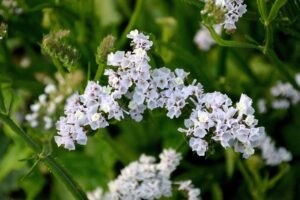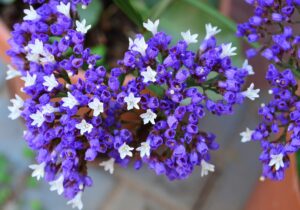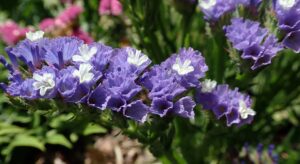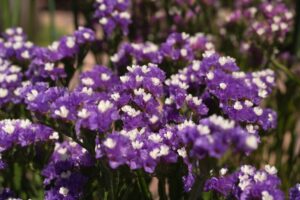Statice, scientifically known as Limonium, while commonly also known as sea lavender is a genus of flowering plants belonging to the Plumbaginaceae family. These hardy perennials are native to Europe, Asia, and North America, with over 120 species found worldwide. Statice plants are highly valued for their vibrant and long-lasting flowers, making them popular choices for both garden cultivation and cut flower production.
Characterized by their dense clusters of small, papery flowers, statice blooms come in an array of colors, including shades of blue, purple, pink, white, and yellow. The flowers are often used in dried flower arrangements, where they retain their color and shape exceptionally well, adding texture and visual interest to bouquets and crafts.

In addition to their ornamental value, statice plants are prized for their resilience and adaptability. They thrive in a variety of growing conditions, including coastal regions, arid landscapes, and temperate climates. Statice is known for its tolerance to drought, poor soil, and salty conditions, making it a popular choice for seaside gardens and xeriscaping projects.
Gardeners appreciate statice for its low-maintenance nature and ability to attract pollinators such as bees and butterflies. The plant’s lance-shaped foliage adds to its appeal, providing a lush backdrop to the colorful blooms. With proper care, statice can bloom prolifically from late spring through fall, bringing months of beauty to gardens, borders, and containers.
Overall, statice is a versatile and resilient plant prized for its vibrant flowers, long-lasting blooms, and ease of cultivation. Whether grown for garden display or harvested for dried flower arrangements, statice adds a touch of color and charm to any landscape or floral design.

Sunlight Requirement of Statice Flower
Statice flowers typically prefer full sunlight to partial shade for optimal growth and flowering. In regions with cooler climates, they may benefit from receiving full sun throughout the day, while in hotter regions, some afternoon shade can help protect the plants from intense heat and prevent wilting. Overall, providing 6 to 8 hours of direct sunlight daily is ideal for promoting healthy growth and abundant blooms in statice plants.

Temperature and Humidity Requirement of Statice Flower
Statice flowers thrive in moderate temperatures and prefer a mild climate. They grow best in temperatures ranging from 60°F to 75°F (15°C to 24°C). While they can tolerate some fluctuations in temperature, they may struggle in extreme heat or cold. As for humidity, statice plants prefer moderate humidity levels.
Soil Requirement of Statice Flower
They prefer well-draining soil with a slightly acidic to neutral pH level, ideally between 6.0 and 7.0. A sandy or loamy soil texture works well for statice plants, as it allows excess water to drain away easily and prevents waterlogging, which can lead to root rot.

When preparing the soil for statice, amend it with organic matter such as compost to improve drainage and fertility. This helps create a loose, friable soil structure that encourages healthy root development and overall plant growth. Avoid heavy clay soils, as they tend to retain too much moisture, which can be detrimental to statice plants.
Propagation of Statice Flower
Statice flowers can be propagated through various methods, including seeds, stem cuttings, and division. Here’s a brief overview of each propagation method:
Seeds
Propagating statice from seeds is the most common method. Start by sowing seeds indoors in seed trays or directly into well-prepared garden soil after the last frost date. Statice seeds germinate best in warm soil temperatures, so ensure the soil remains consistently moist until germination occurs. Once the seedlings have developed several true leaves, they can be transplanted into their permanent growing location.
Stem Cuttings
Propagating statice from stem cuttings is another effective method. Take 4-6 inch (10-15 cm) cuttings from healthy, non-flowering stems of mature plants. Remove the lower leaves from the cutting, leaving only a few leaves at the top. Dip the cut end in rooting hormone to encourage root development and plant the cutting in a well-draining rooting medium. Keep the medium consistently moist and provide indirect light until roots form, usually within a few weeks.
Division
If you have an established statice plant, you can propagate it through division. This method works best in early spring or fall. Carefully dig up the plant and use a sharp knife or shovel to divide the clump into smaller sections, ensuring each division has several healthy roots and shoots. Replant the divisions in well-prepared soil, water thoroughly, and provide appropriate care until they establish themselves.
Regardless of the propagation method used, provide the newly propagated statice plants with adequate moisture, sunlight, and nutrients to support healthy growth. With proper care, they should establish themselves quickly and produce beautiful blooms.

Seed Sowing of Statice Flower
To sow statice flower seeds, follow these steps:
Choose high-quality statice seeds from a reputable supplier. Look for fresh seeds with a high germination rate for the best results.
Statice seeds can be sown directly outdoors after the last frost date in your area. Alternatively, you can start seeds indoors 6-8 weeks before the last expected frost to get a head start on the growing season.
Statice plants prefer well-draining soil with a slightly acidic to neutral pH. Prepare the planting area by loosening the soil to a depth of about 6-8 inches (15-20 cm) and removing any debris or weeds.
If starting seeds indoors, fill seed trays or small pots with a sterile seed-starting mix. Moisten the mix before sowing seeds to ensure good contact between the seeds and the soil.
Plant statice seeds about 1/4 inch (6 mm) deep in the soil. Space seeds 6-8 inches (15-20 cm) apart to allow room for the plants to grow. Cover the seeds lightly with soil and gently pat down the surface.

Keep the soil consistently moist but not waterlogged. Use a gentle spray or misting bottle to water newly sown seeds to avoid disturbing them. Ensure that the soil remains evenly moist until the seeds germinate.
Place seed trays or pots in a warm, bright location with indirect sunlight. A south-facing windowsill is ideal for providing the necessary light for seed germination.
Statice seeds typically germinate within 10-20 days when kept in optimal conditions. Once seedlings emerge, provide them with plenty of light to promote healthy growth.
When seedlings have developed several true leaves and are large enough to handle, they can be transplanted into larger pots or directly into the garden. Space transplanted seedlings according to the mature plant’s spacing requirements.
If sowing seeds directly outdoors, wait until after the last frost date in your area. Prepare the soil as described above and sow the seeds at the appropriate depth. Keep the soil consistently moist until germination occurs.
By following these steps, you can successfully sow statice flower seeds and enjoy beautiful blooms in your garden or containers.
Water Requirements of Statice Flower
Statice flowers have moderate water requirements and prefer soil that is consistently moist but not waterlogged. Water statice plants when the top inch (2.5 cm) of soil feels dry to the touch. Depending on the climate and soil conditions, this typically translates to watering once or twice a week during the growing season. While statice plants prefer moist soil, they are susceptible to root rot if the soil remains consistently waterlogged.

Fertilizer Requirement of Statice Flower
Statice flowers are relatively low-maintenance and don’t require heavy fertilization to thrive. However, providing some fertilizer can help encourage healthy growth and abundant blooms. Apply fertilizer to statice plants in early spring, just as new growth begins to emerge. This provides the plants with nutrients to support vigorous growth and flowering throughout the growing season. Use a balanced, all-purpose fertilizer with an NPK ratio (nitrogen-phosphorus-potassium) of around 10-10-10 or similar.
Apply fertilizer once every 4-6 weeks during the growing season. Avoid over-fertilizing, as excessive nutrients can lead to lush foliage but reduced flower production.
Problems While Growing Statice Flower
While statice flowers are relatively easy to grow, they may encounter some common problems that can affect their growth and appearance. Here are a few issues you might encounter when growing statice flowers and how to address them:
Pest Infestations: Statice plants may be susceptible to aphids, spider mites, and other common garden pests. Monitor the plants regularly for signs of pest infestation, such as distorted leaves or webs, and treat affected plants with insecticidal soap or neem oil as needed.
Yellowing Leaves: Yellowing leaves may indicate nutrient deficiencies, overwatering, or poor soil drainage. Ensure the plants are receiving adequate sunlight, water them only when the soil is dry to the touch, and fertilize them regularly with a balanced fertilizer to provide essential nutrients.
Stunted Growth: If statice plants exhibit stunted growth or fail to produce flowers, they may be lacking essential nutrients or experiencing environmental stress. Address any nutrient deficiencies with appropriate fertilization and ensure the plants are receiving adequate sunlight and water.
Bolting: In some cases, statice plants may bolt, or prematurely produce flowers and seeds, especially if they experience stress or fluctuating temperatures. To prevent bolting, provide consistent growing conditions and avoid planting statice in areas prone to temperature extremes.
By addressing these common problems promptly and providing optimal growing conditions, you can help ensure healthy growth and beautiful blooms from your statice plants.
Ornamental Uses of Statice Flower
Statice flowers, with their papery blooms and long-lasting qualities, are highly valued for their ornamental purposes. Here are some common ornamental uses of statice flowers:
Cut Flower Arrangements: Statice flowers are popular choices for fresh and dried flower arrangements due to their vibrant colors and ability to retain their shape and color even after drying. They add texture and interest to bouquets and floral displays.

Dried Flower Crafts: Statice flowers are often dried and preserved for use in various crafts such as wreaths, potpourri, and dried flower arrangements. Their papery texture and vibrant hues make them ideal for adding visual interest to home décor projects.

Borders and Edging: In garden beds and borders, statice plants can be used as colorful and long-lasting additions. Their low-growing habit and profusion of blooms make them suitable for lining pathways, edging flower beds, or creating colorful borders in garden landscapes.
Container Gardening: Statice plants can be grown in containers or hanging baskets, adding color and texture to balconies, patios, and other outdoor spaces. They are particularly well-suited to mixed container plantings due to their compact growth habit.

Overall, the ornamental uses of statice flowers are diverse and varied, making them versatile plants for both indoor and outdoor settings, as well as for creative projects and floral arrangements.


